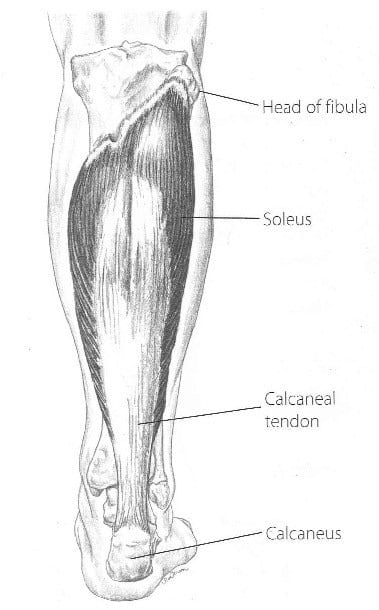Soleus: Learn Your Muscles
The soleus is a muscle that does not get the attention it deserves. Because it is located behind and shares some responsibilities with the gastrocnemius, people often do not realize that there is another muscle on the back of their calf. Yet, this muscle is responsible for keeping us standing upright and is referred to as the body’s “second heart”.
Location

Thanks to Brooklyn Reflexology for the image.
The soleus originates on the upper posterior surfaces of tibia and fibula. This means that the muscles starts on the back of both of the bones in your shin.
Like the gastrocnemius, the soleus inserts onto the posterior surface of the calcaneus (heel bone) via the calcaneal tendon. The calcaneal tendon is more commonly known as the Achilles tendon.
The soleus is mostly located beneath the surface of the gastrocnemius. This sometimes makes it tricky to differentiate between the two muscles. Plus, because of its location beneath the gastrocnemius, the soleus is more difficult to access.
Function
Like the gastrocnemius, the soleus plantar flexes the ankle joint. This means that it helps you point your foot from the ankle.
A function that is unique to the soleus is that it contracts while you’re standing to prevent you from falling forward at the ankle joint. The soleus is key to maintaining your upright posture.
Your Body’s Second Heart
Many people are unaware, but the soleus is sometimes referred to as your body’s second heart. In his article, “Stretching Your Second Heart“, Nic Bartolotta says,
“The vessels that that carry blood in the body are the arteries and the veins. Arteries are thick walled, muscular, high pressured vessels that carry hydrated and oxygenated blood away from the heart to all the tissues of the body. Veins, on the other hand, are thin walled, non-muscular, low pressured vessels that return blood from the various tissues back to the heart.”
Because of their construction, veins need help returning unoxygenated blood to the heart. As your muscles contract, they squeeze your veins, helping to pump your blood. Valves in your veins prevent your blood from flowing backward and pooling in your legs.
The soleus in particular is singled out as the body’s second heart primarily because of its location. It is the muscle located furthest from the heart, and it is at the body’s lowest gravitational point. This means that the soleus is in an ideal position to help pump the blood out of your feet and legs and back toward your heart.
Common Dysfunction
If your soleus is dysfunctional, you might have tight or painful calves. It’s also possible that muscular dysfunction could lead to inflammation in the Achilles tendon. As with all muscles, tears are possible.
These are all rather obvious issues. If you have a pain or tightness in your calf, it could be the soleus. Duh.
However, soleus dysfunction could lead to more subtle issues. For example, because of its role in circulation, swelling in the body, particularly the calves, could be from a dysfunctional soleus. Also, with its role in keeping us upright, I would look at the soleus when addressing balance issues.
According to the August Point Wellness Center,
“Tight, stiff soleus muscles can radiate pain to the heel, ankle, and as far away as the lower back. Complications from soleus tightness include: ankle instability, calf cramps, varicose veins, phlebitis, lower leg edema, low blood pressure, orthostatic hypotension (postural hypotension), and hypersensitivity of lower back. Pain that is mimicked by tight soleus muscle include: plantar fasciitis, heel spurs, stress fracture, shin splints, Achilles tendonitis, and thrombosis.”
If you are in pain, consult your physician. He or she can order appropriate imaging to correctly diagnose your issues and instruct you on the best course of treatment.
Restoring or Maintaining Health
If your injury is not a serious one that requires medical attention, stretching is the best way to restore health to your soleus. As I mentioned earlier, accessing the soleus is a little tricky because it is beneath the gastrocnemius and those two muscles perform some of the same functions. Here are some ideas for how to specifically target the soleus.
- Start with a standing calf stretch. Make sure your front knees is bent and tracking over your toes while your back leg is straight.
- Now, bend your back knee. This will slightly alter the stretch.
- Stand up and place your flexed foot up against the wall. Lean in for a stretch.
- Have a seat and use a yoga strap, towel, or belt to bring your toes and the ball of your foot back toward you.
- While seated, place [easyazon_link identifier=”B003ILP9PY” locale=”US” tag=”custpilandyog-20″]tennis balls[/easyazon_link] on your calves making sure to avoid the back of the knees. With nonchalance, flex and point your feet at the ankle. It is important to be nonchalant with your movements because if you are specifically pointing and flexing your foot, you are asking the gastrocnemius to work. If you are casually moving your foot back and forth from the ankle, you’re asking the soleus to work.
More Information
I consulted [easyazon_link identifier=”1623170206″ locale=”US” tag=”custpilandyog-20″]The Concise Book of Muscles[/easyazon_link] by Chris Jarmey. Recently, the book was revised and is in its third edition. If you are interested in anatomy but not in text books, I highly recommend this book.
Also, I highly recommend reading the articles “Stretching Your Second Heart” by Nic Bartolotta and “The Soleus Muscle, the Second Heart” by the August Point Wellness Center.
What do you do to keep your soleus healthy? Let us know in the comments below.
Thank you for reading this article. If you enjoy the information supplied, please consider supporting this website!
Sign up for my newsletter to get more tips for health and happiness! Also, you can find me on Facebook, YouTube and Pinterest as Custom Pilates and Yoga.